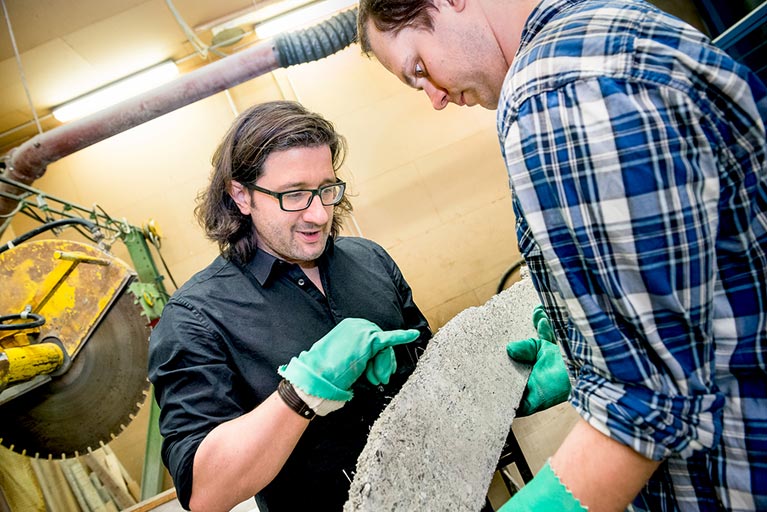Finding a ‘bomb-proof’ steel fibre solution 12 May 2015
After seven-and-a-half years of research, a team from the Institute of Tunnelling and Construction Management has achieved the “impossible” in its search for a bomb-proof shotcrete formula.
The team from the Ruhr University, Bochum – led by Dr Götz Vollmann – has been studying a number of issues relating to tunnel safety as part of an umbrella project sponsored by the Federal Ministry of Education and Research. It has now been able to manufacture shotcrete with an unprecendented 140kg of steel fibres/m3, and the results in tests are impressive.
“When today’s tunnels were built, nobody foresaw that one day a madman with a bomb might seek to destroy them using a bomb,” said Dr Vollmann. In the face of such a threat, engineers are searching for ways to make tunnels and bridges as robust as possible. Construction materials, such as special types of high-performance concrete that can partly absorb the impact of explosions do already exist, but due to their manufacturing principle they cannot be made in anything other than slab form, a fact which clearly presents problems when trying to line surfaces with complex geometries.
“This has been a problem for years,” said Vollmann, who saw that the only possible solution for ‘bomb-proofing’ tunnels would be to develop a new form of shotcrete. But to do so he and his team would have to double the current accepted maximum concentration of 70kg of steel fibres/m3 of shotcrete .
A concrete that is required to be ultra-solid must contain as many steel fibres as possible. Those fibres, however, render it stiff and unsuitable for pumping through a hose and onto the tunnel walls.
“It used to be said that approximately 70kg of steel fibres/m3 of concrete was just about as good as it got. That’s the absolute limit in terms of what is still processable,” explained Dr Vollmann. But after seven-and-a-half years his team has now successfully doubled that ‘limit’, adding 3kg more of synthetic fibres into the mix.
“Everyone with whom we discussed this in the run-up had said: ‘you’ll never pull it off’. And indeed, we were going to throw in the towel,” said Dr Vollman. About to give up, the group had one last brainwave: air. The researchers foamed up the concrete until the mixture contained approximately 20% air bubbles.
“We assume that this process generates a ball-bearing effect of sorts,” said Dr Vollmann. “The fibres presumably roll over the air bubbles, and everything is thus rendered smoother.” Accordingly, the concrete can be pumped through a hose and sprayed through a nozzle despite its high steel-fibre content. However, the air must not remain in the mixture, because this would reduce the strength of the concrete. So, to solve this problem, the RUB team built in a defoaming mechanism.
For the spraying step, the concrete is pumped through a nozzle. There, a substance is added which accelerates the solidifying process. “Otherwise, the concrete would be much too liquid, and, at the required layer thickness, would slide off the wall,” explained Dr Vollmann. “What we have done is simply add a defoaming agent to the accelerating agent.”
Small-scale laboratory experiments showed that the defoaming agent took effect instantaneously, extracting air from the concrete within a fraction of a second of application. This effect has since been verified on a large scale, following experiments with a shotcrete robot.
In a recent test The Institute for Tunnelling and Construction Management and the Institute for Construction Material Technology operated a shotcrete test rig. At the RUB campus, a robot was used to apply shotcrete to a thickness of several centimetres onto traditional concrete. Slabs manufactured in this way were transported to Leipzig – where live fire tests could be carried out in the material testing facilities there; and to the Ernst-Mach-Institut at Fraunhofer, in Freiburg, for controlled explosion tests.
Test results showed that the new shotcrete formula treated slabs retained up to 60% of their load-bearing capacity, compared to just 20% for the unprotected slabs.
For reasons of cost it is of course not possible to apply the new shotcrete to all structures, but at the request of Germany’s Federal Highway Research Institute Dr Vollmann and his team, and other key partners, have identified a process that can be used to identify critical infrastructure that is particularly vulnerable to attack or to fire.
For security reasons the results of this ranking of critical structures cannot be published. The ranking process will now help decide which structures will benefit from additional security measures, and how that security is to be improved.
References
- Critique of synthetic-fiber FRS paper – TunnelTalk, September 2014
- Response to macro-synthetic fibre critique – TunnelTalk Feedback, Nov 2014
- TunnelTECH: Fibre-reinforced concrete for precast segments – TunnelTalk, May 2014
- War on Terror hails shotcrete breakthrough – TunnelTalk, June 2012
- 20 years of fibre concrete linings in the UK – TunnelTalk, Oct 2010
- TunnelTECH: PP fibres to resist fire-induced concrete spalling – TunnelTalk, Nov 2010
- fib Model Code for Concrete Structures 2010 – TunnelTalk, Books & Reports
|
|
|
|
|
Add your comment
- Thank you for taking the time to share your thoughts and comments. You share in the wider tunnelling community, so please keep your comments smart and civil. Don't attack other readers personally, and keep your language professional.




